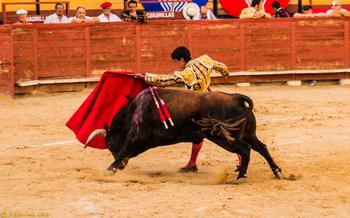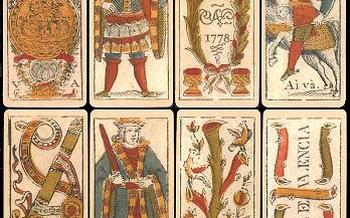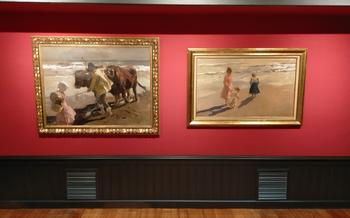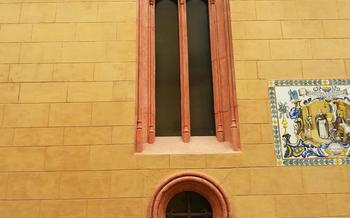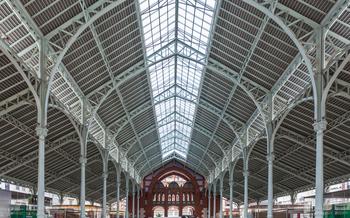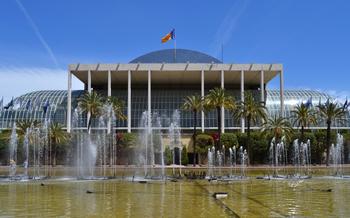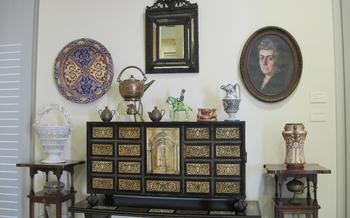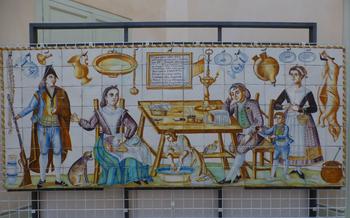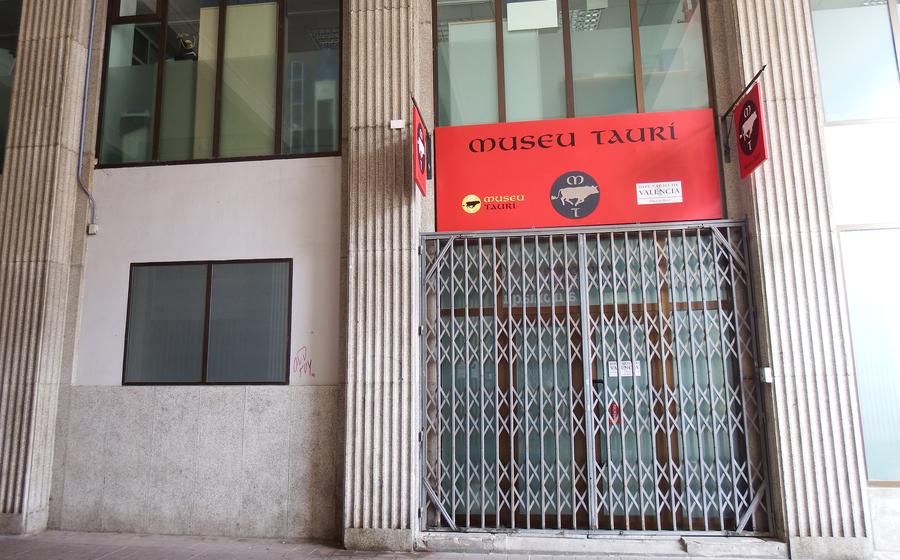
Museo Taurino de Valencia
- Historical Significance
- Museum Location:
- Diverse Exhibits
- Interactive Displays
- Bullfighting Traditions
- Bull Breeds
- Photography and Filming
- Guided Tours
- Souvenirs and Gifts
- Insider Tip:
Historical Significance
Bullfighting, or tauromaquia in Spanish, holds a significant place in the cultural heritage of Valencia and Spain. With roots dating back to ancient times, bullfighting evolved into a complex and intricate art form, deeply embedded in the traditions and customs of the region. The Museo Taurino de Valencia serves as a repository of this rich history, offering visitors a chance to delve into the origins, evolution, and symbolism of bullfighting in Spain.
The museum's exhibits showcase a vast collection of artifacts, including bullfighting costumes adorned with intricate embroidery, colorful posters advertising past bullfights, and an array of tools and equipment used by matadors and their teams. These relics provide a glimpse into the artistry, skill, and pageantry that characterize this unique spectacle.
Moreover, the museum delves into the cultural significance of bullfighting, exploring its role in Spanish society and its influence on art, literature, and music. Visitors can learn about the deep-rooted traditions and rituals associated with bullfighting, gaining a deeper understanding of its enduring appeal and its place in the hearts of many Spaniards.
Museum Location:
The Museo Taurino de Valencia is conveniently situated in the heart of the city, on Calle Xativa 2Visitors can easily reach the museum using public transportation, as it is a short walk from the Colón metro station on Line Alternatively, those arriving by car can find ample parking options in the surrounding streets. The museum is open from Tuesday to Sunday, from 10:00 AM to 7:00 PM, and offers guided tours in both Spanish and English for a more immersive experience.
Diverse Exhibits
The Museo Taurino de Valencia captivates visitors with its diverse collection of exhibits that delve into the rich history and traditions of bullfighting in the city. The museum houses an impressive array of bullfighting costumes, each adorned with intricate embroidery and vibrant colors, showcasing the artistry and craftsmanship associated with the sport. These costumes, worn by legendary bullfighters, offer a glimpse into the grandeur and spectacle of the bullring.
In addition to costumes, the museum showcases an array of posters that encapsulate the history of bullfighting in Valencia. These posters, often vibrant and eye-catching, announce past bullfighting events and depict iconic moments from the sport. Visitors can admire the artistic expressions and graphic designs that have immortalized the names of famous bullfighters and the excitement of the bullring.
Among the artifacts on display, visitors will find bullfighting swords, capes, and other implements used by matadors during a bullfight. These artifacts provide a tangible connection to the techniques and skills employed in the ring, allowing visitors to appreciate the precision and dexterity required in the sport.
One of the highlights of the museum is a life-size replica of a bullring, complete with a sand-covered arena and seating for spectators. This replica offers a realistic glimpse into the layout and atmosphere of a bullfight, allowing visitors to envision the drama and intensity of the event.
Interactive Displays
The Museo Taurino de Valencia captivates visitors with its interactive displays, designed to enhance the visitor experience and provide a deeper understanding of bullfighting. As you explore the museum, you'll encounter various interactive exhibits that allow you to engage with the content in a meaningful way.
One of the interactive displays features a simulated bullfight. Visitors can step into the shoes of a bullfighter and experience the thrill of facing a charging bull. The simulator provides a realistic simulation of the bull's movements and reactions, allowing visitors to practice their bullfighting skills.
Another interactive exhibit showcases a virtual bullring. Visitors can select a bullfighter and watch a virtual bullfight unfold before their eyes. The virtual bullring offers a unique perspective on the sport, allowing visitors to witness the entire spectacle from a safe distance.
In addition, the museum features interactive touchscreens that provide detailed information on bullfighting techniques, famous bullfighters, and the history of the sport. Visitors can explore these touchscreens at their own pace, learning more about the intricacies of bullfighting.
Bullfighting Traditions
In Valencia, bullfighting is deeply ingrained in the cultural fabric and holds a significant place in the city's traditions. The bullfight is not merely a spectacle but a ritualized event steeped in symbolism and cultural meaning. For Valencians, the bullfight represents a display of courage, skill, and artistry, where the matador engages in a symbolic dance with the bull.
The bullfight is a highly choreographed performance, with each movement and gesture carrying specific significance. The matador, dressed in an elaborate traje de luces (suit of lights), leads the bull into the ring, using a red cape to provoke and test the animal's strength and agility. The bull's horns are blunted to reduce the risk of fatal injuries, and the matador's goal is to demonstrate his mastery over the bull without causing unnecessary harm.
The bullfight is divided into three stages, or tercios. In the first tercio, the matador uses the cape to test the bull's strength and agility, assessing its temperament and reactions. In the second tercio, the matador uses banderillas, or barbed darts, to weaken the bull's neck muscles and prepare it for the final stage. The third tercio is the moment of truth, where the matador attempts to kill the bull with a single, well-placed sword thrust.
The bullfight is a controversial spectacle, and opinions on its ethical implications vary widely. However, for many Valencians, it remains a deeply rooted tradition, a symbol of courage, skill, and cultural identity.
Bull Breeds
The bulls used in bullfighting are specially bred for their strength, agility, and aggression. These breeds have been carefully selected and cultivated over centuries to produce animals that are both powerful and predictable. The most common breeds used in bullfighting are the Lidias and the Bravos.
Lidias are a Spanish breed known for their large size, muscular build, and aggressive temperament. They are typically black or dark brown in color and have long, sharp horns. Bravos, on the other hand, are a Portuguese breed that is slightly smaller than the Lidias but equally aggressive. They are usually black or gray in color and have shorter, more curved horns.
In addition to these two main breeds, there are several other breeds of bulls that are occasionally used in bullfighting. These include the Miuras, the Santa Coloma, and the Jandilla. Each of these breeds has its own unique characteristics and is prized by bullfighting enthusiasts for different reasons.
The selection of the right bull for a bullfight is a critical decision. The bull must be large enough to pose a challenge to the matador, but not so large that it is uncontrollable. It must also be aggressive enough to attack the matador, but not so aggressive that it is dangerous to the spectators. The breeder's skill in selecting and breeding the right bulls is essential to the success of a bullfight.
Photography and Filming
Capturing the essence of bullfighting through photography and filming can be a rewarding experience for visitors. However, it's important to be aware of the rules and etiquette surrounding these activities. Photography and filming are generally permitted inside the Museo Taurino de Valencia, allowing visitors to document their visit and capture the intricate details of the exhibits. However, using flash photography is often discouraged as it can be disruptive and disrespectful to other visitors.
During a bullfight, photography and filming are typically allowed for personal use, but commercial photography or filming may require special permission or accreditation. It's essential to respect the privacy of the bullfighters and spectators and to avoid capturing images that could be intrusive or disrespectful. Additionally, using a tripod or other bulky equipment may be restricted in certain areas of the bullring.
To capture the best shots, it's advisable to arrive early and secure a good vantage point. Using a camera with a telephoto lens can help bring the action closer, while a tripod can provide stability for sharper images. It's also important to be mindful of the lighting conditions, which can change throughout the day and affect the quality of your photographs.
By following these guidelines and respecting the rules, visitors can capture memorable images and videos that will serve as lasting reminders of their experience at the Museo Taurino de Valencia and a bullfight in Spain.
Guided Tours
Complement your visit to the Museo Taurino de Valencia by taking advantage of the guided tours offered. These tours provide an immersive and educational experience, allowing you to delve deeper into the world of bullfighting and its cultural significance. Knowledgeable guides will accompany you through the museum's exhibits, sharing insights into the history, traditions, and techniques of bullfighting. Guided tours are available in various languages, ensuring that visitors from all backgrounds can appreciate the museum's treasures. Whether you're a first-time visitor or a seasoned aficionado, guided tours offer a unique perspective and enhance your understanding of this controversial yet captivating tradition.
Souvenirs and Gifts
The Museo Taurino de Valencia offers a unique opportunity to purchase souvenirs and gifts related to the fascinating world of bullfighting. Visitors can find a wide range of items, such as books, posters, and traditional bullfighting attire. These souvenirs are not only a reminder of the visit to the museum but also a way to support the preservation of this cultural heritage.
For those looking for more unique gifts, the museum shop has a selection of handmade crafts and artifacts related to bullfighting. These items, often created by local artisans, are not only beautiful but also hold cultural significance.
Another popular item is the "capote," the traditional cape used by bullfighters. Visitors can purchase a replica of the capote or even a full bullfighting costume. These items are perfect for enthusiasts who want to take their passion for bullfighting to the next level.
Whether it's a book, a poster, or a piece of traditional clothing, a souvenir from the Museo Taurino de Valencia is a meaningful way to remember the experience and celebrate the rich heritage of bullfighting in Spain.
Insider Tip:
For an authentic Valencian experience, plan your visit to coincide with the Fallas de Valencia, an annual festival held in March that features elaborate parades, fireworks, and bonfires. Immerse yourself in the city's vibrant culture and enjoy the unique opportunity to witness this renowned celebration. Alternatively, take advantage of the free admission offered on Sundays and public holidays to save on entrance fees and make the most of your visit.
